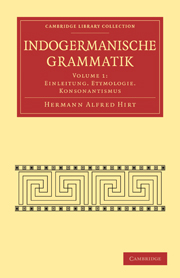Book contents
- Frontmatter
- Vorwort
- Contents
- Literaturangaben
- Verzeichnis der Abkürzungen
- Einleitung
- Erster Teil. Etymologie
- XI. Kapitel Die Lautlehre
- XII. Kapitel Grundgesetze der etymologischen Forschung
- XIII. Kapitel Die Bedeutung der Wörter
- XIV. Kapitel Verwandte und entlehnte Wörter
- XV. Kapitel Verlust von Worten
- XVI. Kapitel Etymologie und Kulturgeschichte
- Zweiter Teil. Der idg. Konsonantismus
- XVII. Kapitel Die Sonorlaute
- XVIII. Kapitel Die Zischlante
- XIX. Kapitel Idg. j und w
- XX. Kapitel Die idg. Tenues und Mediä
- XXI. Kapitel Die idg. Mediä aspiratä
- XXII. Kapitel Die Lautverschiebung
- XXIII. Kapitel Das Hauchdissimilationsgesetz im Griechischen und Indischen
- XXIV. Kapitel Die Gutturalreihen
- XXV. Kapitel Die Tenues aspiratä
- XXVI. Kapitel Sonstige Laute des Idg
- XXVII. Kapitel Konsonantenverbindungen
- XXVIII. Kapitel Die r-Verbindungen
- XXIX. Kapitel Die l-Verbindungen
- XXX. Kapitel Die n-Verbindungen
- XXXI. Kapitel Die m-Verbindungen
- XXXII. Kapitel Die w-Verbindungen
- XXXIII. Kapitel Die j-Verbindungen
- XXXIV. Kapitel Die s-Verbindungen
- XXXV. Kapitel Veränderungen des Konsonantenstandes im Idg. Schwund von Konsonanten
- XXXVI. Kapitel Konsonantenwechsel
- XXXVII. Kapitel Auslautsgesetze
- XXXVIII. Kapitel Der Anlaut
- Autorenverzeichnis
- Sachverzeichnis
- Wörterverzeichnis
XXX. Kapitel - Die n-Verbindungen
Published online by Cambridge University Press: 05 August 2011
- Frontmatter
- Vorwort
- Contents
- Literaturangaben
- Verzeichnis der Abkürzungen
- Einleitung
- Erster Teil. Etymologie
- XI. Kapitel Die Lautlehre
- XII. Kapitel Grundgesetze der etymologischen Forschung
- XIII. Kapitel Die Bedeutung der Wörter
- XIV. Kapitel Verwandte und entlehnte Wörter
- XV. Kapitel Verlust von Worten
- XVI. Kapitel Etymologie und Kulturgeschichte
- Zweiter Teil. Der idg. Konsonantismus
- XVII. Kapitel Die Sonorlaute
- XVIII. Kapitel Die Zischlante
- XIX. Kapitel Idg. j und w
- XX. Kapitel Die idg. Tenues und Mediä
- XXI. Kapitel Die idg. Mediä aspiratä
- XXII. Kapitel Die Lautverschiebung
- XXIII. Kapitel Das Hauchdissimilationsgesetz im Griechischen und Indischen
- XXIV. Kapitel Die Gutturalreihen
- XXV. Kapitel Die Tenues aspiratä
- XXVI. Kapitel Sonstige Laute des Idg
- XXVII. Kapitel Konsonantenverbindungen
- XXVIII. Kapitel Die r-Verbindungen
- XXIX. Kapitel Die l-Verbindungen
- XXX. Kapitel Die n-Verbindungen
- XXXI. Kapitel Die m-Verbindungen
- XXXII. Kapitel Die w-Verbindungen
- XXXIII. Kapitel Die j-Verbindungen
- XXXIV. Kapitel Die s-Verbindungen
- XXXV. Kapitel Veränderungen des Konsonantenstandes im Idg. Schwund von Konsonanten
- XXXVI. Kapitel Konsonantenwechsel
- XXXVII. Kapitel Auslautsgesetze
- XXXVIII. Kapitel Der Anlaut
- Autorenverzeichnis
- Sachverzeichnis
- Wörterverzeichnis
Summary
n verbindet sich weit schwieriger mit den Konsonanten, und wir stoßen daher hier schon auf beträchtliche Lücken.
pn fehlt den meisten Sprachen, so dem Lat. Kelt. Lit. Slaw. Ind.
Im Griech. findet es sich im Stamm πνευ- ‘wehen, blasen’, in πνίγω ‘ersticke’ und in πνύε ‘Volksversammlung’.
πνευ- hat man zu ahd. fneham ‘atmen’ gestellt. Auch πνί-γω ‘ersticke’ dürfte dazu gehören. πνύε ist dunkel.
Die Lautgruppe pn dürfte daher vereinfacht sein. Zu 1. penus ‘Speisevorrat’ könnte nūtrīre ‘nähren’ gehören. Unsicher.
bn fehlt überall, abgesehen von got. bnauan, s. u. Es wäre wohl zu mn geworden.
bhn findet sich vielleicht in gr. ϕνεί, Interjektion zur Nachbildung des schnaubenden Nasenlautes und in got. bnauan ‘zerreiben’, das man aus bi-nauan erklärt. bh dürfte daher vor n geschwunden sein.
Für Etymologien, in denen man n auf bhn zurückfführen könnte, bietet sich vor allem die Basis nedh, nodh (1. nōdus ‘Knoten’, ahd. nestilo ‘Bandschleife’, vgl. Walde unter necto): idg. bhendh ‘binden’.
tn ist nirgends vorhanden.
Da Gruppe tn im Anlaut nicht vorhanden ist, so hat es sie möglirherweise auch nicht im Inlaut gegeben, sie ist, wo sie vorhanden war, erleichtert worden. und zwar durch Schwund des n. Dafür spricht die Tatsache, daß im Indischen zu gewissen Adjektiven auf -ta das Fem, auf -nî ausgeht, also róhita-und lóhita- ‘rot’, und dazu rôhinî und lōhinī: zu háritas ‘grün’ gehört hariuī; zu étas ‘hunt’ énī, zu sjētás ‘weiß śjēní.
- Type
- Chapter
- Information
- Indogermanische Grammatik , pp. 270 - 275Publisher: Cambridge University PressPrint publication year: 2009First published in: 1927



